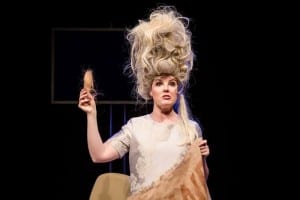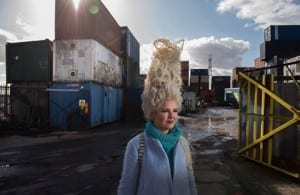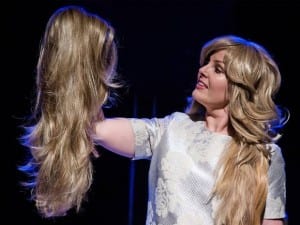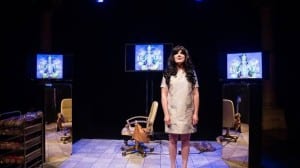Last week I watched the fantastic Victoria Melody perform another one of her smash hit shows. Melody is an award winning solo performance artists with a background in Fine Art. What I absolutely loved about her was her personality. She was full of energy and seemed to be comfortable around everyone she spoke to. One reviewer stated that ‘she is either an idiot or a genius, it’s up to you to decide’ (Melody, 2010). Personally I think she’s a genius. Her infectious personality clearly transposed into her performance as she managed to confidently portray quite serious social issues, whilst being ‘unpretentiously funny’ (Hutera, 2015). Her background in Fine Art means she explores the scenarios and topics in great depth. She often ‘immerses herself into communities and become an active participant in the rituals as research for her work’ (Melody, 2010).Throughout her careers she has immersed herself with numerous social groups and careers. She has become a pigeon racer, a champion dog handler, a northern soul dancer and a beauty queen. It was her experience as a beauty queen that influenced her next performance Hair Peace (2016).
Hair Peace (2016)
Hair Peace was an exploration into the origins of hair extensions. Whilst partaking in Mrs Brighton beauty pageant for her show Major Tom (2014) she wondered who the hair extensions that were being sown into her head belonged to. This prompted her to travel the world and speak to members of the hair industry, forensic scientists, and those whose hair makes the extensions. One review stated that ‘it is the journey rather than the arrival that is interesting here’ (The Guardian, 2007), which I believe sums up this performance very nicely. It was certainly interesting, as an audience member, to be taken on this journey of discovery into the profitable work of the hair market.
What I took from the performance
- Her casual style of delivery – It didn’t seem as though she was acting at all, but rather explaining her story to a group of friends. Personally, her casual performance really put me at ease, and by the end of it I felt weirdly comfortable around someone that I met only an hour ago. I would really like to incorporate this casual delivery into my performance.
- When asked how much she improvised, she stated that it is 70% scripted, 30% improvised – This keeps the performance exciting as it allows her to occasionally deviate off script to react to the audience. Having a strict structure can affect the relationship between the actor and audience. It can make the whole performance feel more formal. I want to create a relaxed atmosphere and connect with my audience to allow them to become part of the performance, and if they wish to engage in conversation with me, then the structure will allow for deviations.
- The structure of the performance and layout of the set – The set was three televisions placed in three corners of the performance space. Each screen represented a separate person (her sister, the forensic scientist, and her friend in India). I really liked this layout. Three separate areas for three separate people, and the televisions representing these people. I think that I would be able to incorporate this into my solo performance with the three people I wish to talk about (my boyfriend, parents and sister).
- The use of media and home videos – Not only did the televisions project the three people, but also videos of her in the pageants, photos of her sister, and videos of her time in India. Such videos allows the audience to understand the backstory to her performance. The videos and pictures of her sister allowed the audience to know her as a person more than a name, which allowed them to get more involved in the narrative. The same with the videos of her in the beauty pageants. This has made me consider the use of media and video in my performance. This would complement the verbal explanation of my story and enable the audience to visibly see what I will be discussing. For this I want to use a short video compilation of my home videos that will be projected at the beginning of the performance, before the lights have come up on me, and before any spoken dialogue. I have many (rather embarrassing) home videos of me performing in my living room to my (very patient) parents. Luckily my mum captured most of my existence on video tape, so there are plenty of clips of myself performing, right up until the present day. These will allow the audience to understand that I’ve wanted to perform since a young age, thus the performance concept will hopefully become clearer.
Bringing the screen into the theatre
Using multimedia on stage is a relatively recent phenomenon in the large scale of theatre. ‘Where early television advertised itself as bringing theatre into your home, it seems now as if theatre advertises itself as bringing television or cinema into your local theatre’ (Giesekan, 2007,4). Many performers and theorist believe that the inclusion of multimedia element destroys the liveness of theatre as ‘performance gains its power from the fact that it is created as we watch’ (ibid, 1). However, I personally disagree with this as the inclusion of video can create a new layer of space and time within the live performance. Freda Chapple and Chiel Kattenbelt agrees with this concept and state that ‘the closed continuum of time can be broken, as video can introduce a different dimension of time in the performance’ (Chapple and Kattenbelt, 2006, 71). Thus through video I would be able to take the audience to different moments in time, such as my childhood, and bring external people into the performance space via digital media.
Work Cited
Chapple, C., Kattenbelt, C. (2006) Intermediality in Theatre and Performance. Amsterdam: Rodopi.
Hutera, D. (2015) Hair Peace at Pleasance Courtyard, Edinburgh Festival. London: The Times. Available from http://www.thetimes.co.uk/tto/arts/stage/edinburgh-festival/article4527528.ece [Accessed 8 March 2016].
Melody, V. (2010) Victoria Melody: About. Available from http://www.victoriamelody.co.uk/about/index.php[Accessed 6 March 2010].
Melody, V. (2010) Victoria Melody. Available from http://www.victoriamelody.co.uk/home/index.php [Accessed 6 March 2010].
The Guardian. (2007) Hair Peace at Edinburgh festival review – the secret life of locks. [online] London: The Guardian. Available from http://www.theguardian.com/stage/2015/aug/24/hair-peace-at-edinburgh-festival-review-victoria-melody-pleasance [Accessed 7 March 2016].
Giesekam, G. (2007) Staging the Screen: The Use of Film and Video in Theatre. Basingstoke: Palgrave Macmillan.




